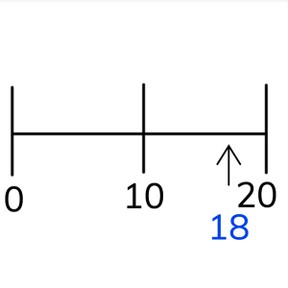
Approximate placement of numbers to 20 on the number line
Approximate placement of numbers to 20 on the number line



8,000 schools use Gynzy
92,000 teachers use Gynzy
1,600,000 students use Gynzy
General
Students learn to approximately place numbers to 20 on the number line, also when the number line only shows 0 and 20.
Common core standard(s)
K.CC.A.1
K.CC.A.2
Relevance
Discuss with students that it is important to be able to approximately place numbers on the number line. If you know the approximate placement, it will help determine if numbers are bigger or smaller because you know which number it is close to.
Introduction
Show students a number line. The numbers are missing. Count forwards and backwards to 20. Explain that the number line is a line with numbers placed in their correct position. Complete the number line to 20. First fill in 0, 20 and 10 and then ask students to name and guess the rest of the numbers.
Development
Show the students the two number lines on the interactive whiteboard, one with lines, the other without. Ask students what the difference is between the two. Discuss that on the first number line you can see exactly where every number belongs and that you can't see that on the second number line. Introduce the term "approximate" and say that it means you don't know exactly but you have a rough idea. Tell students that if you place numbers on an empty number line, that they first have to find the middle. The number in the middle of 0 and 20 is 10, so that is the middle. Place a number on the number line by first determining the middle and then by looking to see if the number comes before or after the middle, and then approximating where it belongs. The first number that you'll place together is under 10. The next one is above 10. Show this step by step by moving the covers on the interactive whiteboard. Show students a number line with 0 and 20 and a line in the middle. Discuss that the number is just above the middle. That means it is 12. Practice this with another but then with a line just before the end of the number line. Discuss that it is just a little less than 20, so it is 19. Finally practice if students can recognize a number on an empty number line. Have them start with finding the middle of the line and then by counting forward or back to find the closest number. Check if their answer is correct by comparing it to the number line below. If this is unclear for students, you can write the lines and numbers on the blank number line to show the process.
Check that students are able to approximate placement of numbers to 20 on the number line by asking the following questions:
- What should you do if you want to approximate placement of a number on the number line?
- If you have a number line with number cards from 0 to 20, which number is useful to place first on the number line?
- How do you approximate placement of a number on the number line? (by counting forward or counting backwards)
Guided Practice
Students first practice placing numbers on an empty number line, with the middle of 10 as well as possible answers that they need choose from being given. Next they get a number line from 10 to 20, where they need to place an imaginary line at 15 to determine the placement. Finally they get a number line from 0-20, where they need to place an imaginary line at 10 to determine the placement.
Closing
Discuss again that you can use your knowledge of approximate placement of numbers to 20 to help determine which numbers are bigger and smaller. Check that students know the steps by which they do approximate placement- first finding the middle (10), looking if it is above or below the middle, and then finding its position. Ask students to draw a number line in pairs. Give each student 5 number cards to 20. In turns they approximate placement of one of their number cards on their number line. They take turns.
Teaching Tip
Students who have difficulty approximating can use the number lines with intermediate lines from 1 to 20. Have the student draw the complete number line to help support their understanding.
Instruction materials
number cards from 0-20
The online teaching platform for interactive whiteboards and displays in schools
Save time building lessons
Manage the classroom more efficiently
Increase student engagement
Discover more!
About Gynzy
Gynzy is an online teaching platform for interactive whiteboards and displays in schools.
With a focus on elementary education, Gynzy’s Whiteboard, digital tools, and activities make it easy for teachers to save time building lessons, increase student engagement, and make classroom management more efficient.



